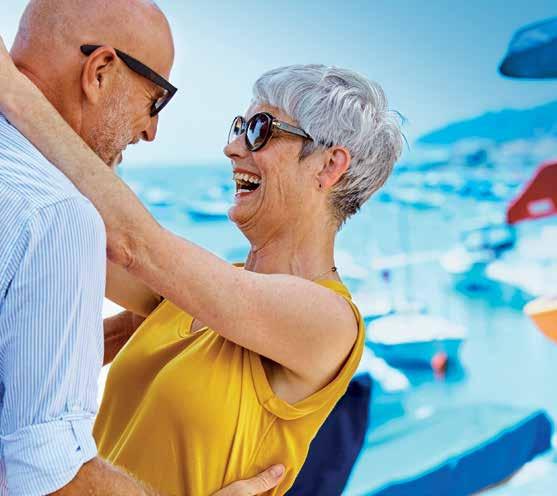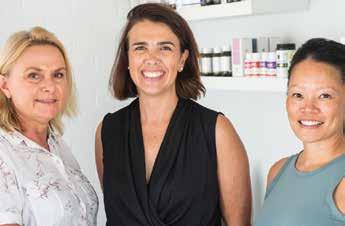
5 minute read
Getting through difficult times…
WEALL EXPERIENCE THEM AT SOME POINT, THERE ARE TIMES IN OUR LIFE THAT ARE MORE CHALLENGING THAN OTHERS. WHILST THERE IS NO WAY TO AVOID THESE TRYING TIMES, THERE ARE WAYS TO MAKE THESE MOMENTS EASIER. THE MORE RESILIENT YOU ARE, THE BETTER YOU ARE AT TOLERATING EMOTIONAL DISTRESS GENERATED BY DIFFICULT EXPERIENCES. IT HELPS YOU ADAPT AND BOUNCE BACK MORE QUICKLY FROM HARDSHIP RESILIENCE CAN BE BUILT BY: ALLOW YOURSELF TO FEEL. When painful emotions arise, sometimes it feels like it is easier to ignore them. Allowing feelings to arise, even the deepest sadness or grief, creates a space for healing to take place.
HAVE ACCEPTANCE.
Advertisement
In life, there are things we can change and things we cannot. We must have the wisdom to know the difference. When we live in this way, it gives us the freedom to devote our energy to things we can transform into something positive.
PRACTICE SELF-LOVE
Taking care of the mind, body, and spirit; means getting adequate sleep, exercising, eating well, being kind and nurturing yourself.
Take time to relax, meditate and breathe.
TAKE TIME IN NATURE. Find purpose.
Whether it is a hobby or an activity, bringing pleasure into our lives helps us manage periods of stress.

Assisting others can take us away from our own issues and can give us a clearer perspective. It can also bring a sense of purpose.
BE POSITIVE.
In the darkest of times, there is always light. I believe, there is always one positive thing that can be found, even in the bleakest of moments, often many when we look close enough. To have had the experience, growth or love is a precious gift.
It is easier to be positive when we can break a situation down and manage one thing at a time.
Find ways to be motivated and keep going.
Take a step back from the situation and observe it as an outsider; you may view things from a different perspective. Celebrate everything wonderful and practice gratitude.
Thoughts and words become things, so be mindful.
CONNECT WITH OTHERS. It can help to talk things through. This helps you express and aids in clarifying your thoughts and feelings. Being with others provides support and reminds us that we are never alone.
Sharing time with others has many benefits physically, mentally, and emotionally. Get out there and connect with positive uplifting people. If you need help, seek someone like myself who can gift you tools to take control of your life, by empowering yourself.
I can be reached on 0405 361 882 or on Facebook: MariaChristina.Love
Always with love, Maria Christina x
HAVE TENNIS OR GOLFER’S ELBOW?
Though elbow pain is common in athletes - and we do see our fair share of tennis players, golfers, pickleball players, and lawn bowlers - it is also common in those that perform repetitive tasks, such as avid gardeners. Tennis elbow refers to the inflammation of the tendons where they attach on the lateral (thumb side) of the elbow, whereas golfer’s elbow refers to the tendons on the medial (pinky side) of the elbow. They are also known as lateral epicondylitis and medial epicondylitis, respectively. The pain can vary from a burning sensation at the elbow to shooting pains down the forearm. When impacted, lifting minor objects, even as light as a coffee cup, can cause severe pain.
Other common symptoms include:
• Tenderness on the lateral or medial side of the elbow
• Pain when opening the hand (tennis elbow) or pain when making a fist (golfer’s elbow)
• Difficulty holding, pinching, or gripping objects
When addressing tennis or golfer’s elbow, it is important to also assess the affected muscles in the forearm - which are often tight - in addition to the tendons themselves. Affected muscles often have become shortened/ tightened with overuse, and therefore put increased strain on the tendons and compound the pain.
Acupuncture For Elbow Pain
Typical treatments for elbow pain include over-the-counter pain relievers and cortisone injections, however acupuncture is commonly used as an effective, minimally invasive treatment to restore pain-free movement. There are several acupuncture techniques that may be used when treating elbow injuries, depending on each individual case. All of the techniques however, stimulate healing by bringing oxygenated blood to the injured area to flush out toxins and lactic acid, and to reduce inflammation. The techniques include:
• Electroacupuncture: with acupuncture needles inserted at targeted areas of your elbow and forearm, a device is connected to the needles to deliver an electrical pulse. The stimulation relaxes the muscles, increases blood flow, and stimulates endogenous opioid endorphins, the body’s natural pain-relieving chemicals.
• Motor point acupuncture: motor points are specific locations in the muscles where the motor nerve can be easily stimulated. When an acupuncture needle is used on a motor point with an electric impulse, it creates a contraction and relaxation which releases tight contracted bands of muscle. This is like hitting a muscle reset button which provides pain relief and improved muscle contractibility and mobility.
• Gua Sha is a type of friction massage that is used to stimulate circulation of oxygenated blood, remove scar tissue, and increase collagen production to promote healing.
• Moxibustion involves external use of the herb mugwort (also known as moxa), which facilitates healing by reducing inflammation and increasing blood circulation.
We see elbow pain regularly in our clinic - both acute and chronic cases. The number of treatments needed varies with each person, however fewer treatments are typically required if the injury has just recently occurred. On average, patients with elbow injuries receive six treatments over three weeks. Treatment plans vary depending on the severity of the injury and individual response to acupuncture. To reduce the chance of injury:
• Avoid repetitive tasks involving your arms and heavy lifting for extended periods
• Be mindful of tension in your forearm muscles over a prolonged duration of time
• Regularly stretch your forearms and hands to improve circulation
A Brief History Of Acupuncture
6000 BCE - Sharp bone and stone instruments are discovered in China, described as ‘pieces of stone used for treating illness by pricking the body’.
198 BCE - Burial tombs, amongst other artifacts unearthed in 1973, depict a medical practice related to acupuncture meridian systems.
552 AD - Acupuncture begins its migration from China to Japan and Korea.
1368-1600 - Acupuncture becomes one of the primary care systems used in China, alongside herbs, massage, diet, and moxibustion.
1500-1700 - The Dutch East India Company introduces acupuncture to Europe.
1822 - Acupuncture suffers a decline in China.
1880 - Acupuncture is introduced in Australia during the gold rush period by Chinese gold diggers.
1949 - Following the installation of the Communist government in China, all traditional forms of medicine are re-established and encouraged, including acupuncture.
1971 - In preparation for the unprecedented visit to China by US President Nixon, a US press corps member is treated with acupuncture following an emergency appendectomy. He describes his experience in the New York Times and as a result, teams of US physicians tour China to assess acupuncture's therapeutic applications.
1979 - The World Health Organisation conducts a symposium on acupuncture in China.
1997 - The National Institute of Health in the United States declares there is sufficient evidence of acupuncture's value to expand its use into conventional medicine.
2000 - Research into acupuncture as a medical treatment grows exponentially, increasing at twice the rate of research into conventional biomedicine. From 20002020, there have been over 13,000 studies conducted in 60 countries, including hundreds of meta-analyses.
2012 - Mandatory national registration of acupuncturists with the Chinese Medicine Board of Australia, under the governance of the Australian Health Practitioner Regulation Agency, a government body that manages the registration of all health practitioners.

2017 - The Acupuncture Evidence Project reviewed the effectiveness of acupuncture for 122 treatments over 14 clinical areas. Evidence of effect was found for 117 conditions, including knee osteoarthritis, lower back pain, and headache. If you’d like to make a booking or if you’d like to discuss whether acupuncture and Chinese medicine is right for you, please contact usJessica, Wendy, and Katherine - via our website www.bribieacupuncture. com.au or call 0423 160 228. You can also find us on Facebook and Instagram @bribieacupuncture. HICAPS is available onsite. Pensioner discounts available.
4/29 Benabrow Avenue, Bellara (behind the James Moore law office).








